 |
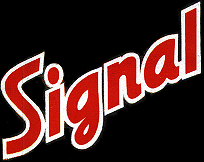 | Signal. Sonderausgabe der
Berliner Illustrirten Zeitung.
Deutscher Verlag Berlin,
1940 – 1945. |
|---|
[ Galleries ] → Bits And Pieces: Signal Paraphernalia
A multitude of items related to Signal was produced and distributed in wartime Europe. This growing gallery presents a selection of interesting objects from both my personal collection and the archives of Signal collectors around the world. If you have similar items to share I would consider it an honor to feature them here. You can submit pictures and descriptions via email.
A. Finnish Postcard Featuring Signal
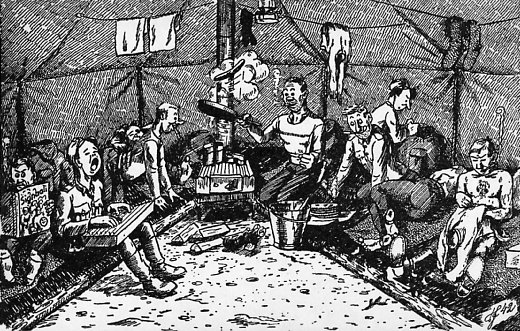
Fig.1 This Finnish fieldpost card from 1942 depicts a bunch of jolly soldiers relaxing in their tent near the frontlines. The man on the left is reading a copy of Signaali, the Finnish edition of the magazine. |
Fig.2 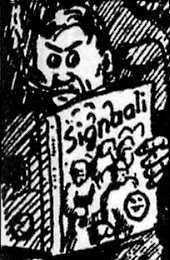 Fig.3 Fig.3 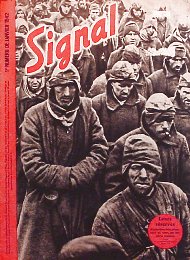
Upon closer inspection we find that the artist created a faithful rendition of the cover of issue number 1/1942, which shows scores of Russian prisoners of war being marched off into captivity.
1/1942 was the first issue published in the Finnish language. It is of some interest that this issue alone seems to have made a sufficiently strong impression on the Finnish artist that he decided to include it in his drawing. (We do however have to consider the possibility that the artist had previously seen the German edition of the magazine, which had been circulated in Finland for some time.)
The cover photo of 1/1942 was taken by Kriegsberichter Roeder. The photo caption in the 'red dot' labels the captured Russians as "Ersatz", a word that has found its way even into the English language as a pejorative term for a substitute or replacement of inferior quality. The greater portion of the Russian POWs interned by the Germans during World War Two did not survive captivity, often starving to death or dying from diseases as a result of deliberate shortcomings in supply and administration. |
B. Subscription Banderole

A banderole used in mailing the magazine to a subscriber
in Helsingfors (Helsinki), Finland.
Scan provided by Raimo Kotiranta. |
C. Posters Advertising Signal
Fellow collector and researcher Enrique Xesta has contributed this photo of a poster advertising the newly-created Swedish edition of Signal:
"Up-to-date coverage — entertainment, culture, film, theatre, fashion, humour. SIGNAL, the well-informed European magazine — in Swedish. Get it now at the nearest newsstand."
To my knowledge this is the first time that this type of poster has come to light. It should be considered to be of exceptional rarity.
The first number to be published in Swedish, code Sch., was issue 7/41. Since this poster uses the cover of 8/41, we must assume it was only designed after distribution of the new edition had begun.
|
|
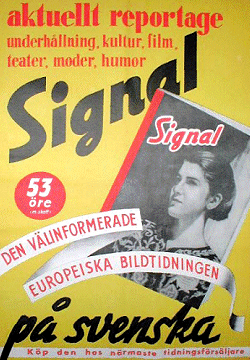
"SIGNAL på svenska", 70 x 100 cm, 1941,
Collection Enrique Xesta.
|
| 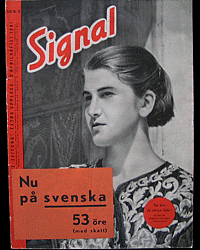
Signal Sch 8/41 with "Nu på
svenska" note, Collection
Thomas Pettersson.
|
|
Quite appropriately, Sch 8/41 was distributed with a glued-on note on the front cover which also announced the newly launched edition. Many thanks to Thomas Pettersson for submitting the cover photo.
As a trivia note, the Swedish edition was initially planned to be produced under the title "Signalen" ("The Signal"). Much to the Deutscher Verlag's dismay that name was already rights-reserved to a small railway periodical, so it was decided to go with the German title + "Bildtidningen", or illustrated magazine, instead.
Remarkably, this text is not yet present on Sch 8/41.
|
2. The Netherlands
This Dutch poster uses a nautical theme to promote the magazine. Of note is the fact that it specifically mentions subscriptions.
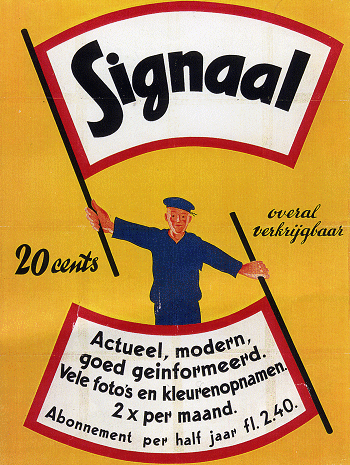
"Signaal — overal verkrijgbaar",
unknown year and measurements.
|
|
3. France
Reproducing a 19th Century drawing by Honoré Daumier, an artist famous for his caricatures and portraits of the French bourgeois, this poster promotes the French edition of Signal.
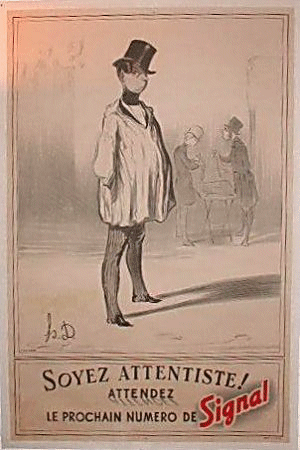
"Soyez Attentiste!"
120cm x 160cm, France, ca 1942
|
|
Elaborating on the propa- gandistic trick hereby played on the French, the present owner explains:
"'Soyez attentiste' is kind of a joke because it means 'just wait'. At that time (around 1942) 90% of the French people were neither in favor of collaboration nor resistance. They just wanted to find some food. They were referred to as "attentistes" which in French means "those who do not take any decision" in favor of one camp or the other.
"German propaganda played on that and the Signal motto means 'Do not do anything... just wait for the next issue of the magazine Signal... in order to make a 'good' decision."
Photo of poster reproduced with kind permission of PropagandaPoster.com.
|
In a pictorial titled "Pariser Plakat", a copy of Wiener Illustrierte shows this type of advertising poster still being used to promote Signal in 1944:
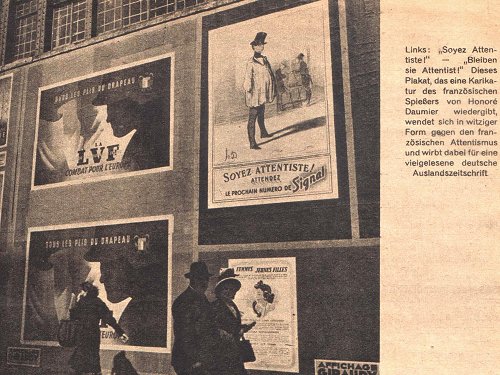
Wiener Illustrierte, No 26 (June 28) 1944. Scan courtesy of Jeff Hanson.
|
D. Storage Binders
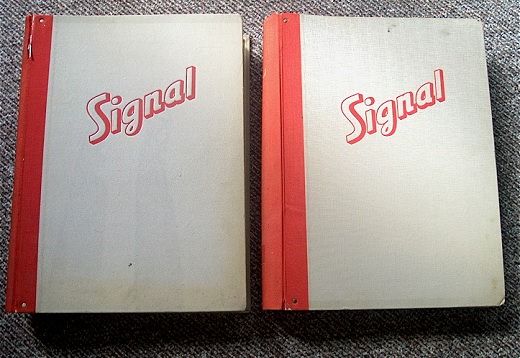
Although a multitude of custom bindings and covers exist, the pictured specimen appears to have been the only authorized storage solution for Signal. Sold mainly (or possibly exclusively) in Switzerland, the binders were advertised on flyers included with regular copies of Signal (see below for an example of these advertisements). It is likely they initially appeared on the market during the first half of 1942.
The authorized supplier for Switzerland was a travel agency (!) in Basel; this business also had a stock of back issues that could still be ordered by anyone interested in starting their own Signal collection. Since the first edition of the binders was sold out within a matter of weeks, a second edition was issued shortly thereafter with minor differences in construction. It is also possible that there are rather subtle modifications within one and the same version as a result of material shortages.
The binders are detachable and sport an embossed "Signal" logo on the front as well as a smaller, gilt reproduction of the logo on the spine. Magazines were affixed using a set of metal 'springs' or wires; these were simply stuck between the binder's spine and the centerspread of each magazine. As a result magazines could be removed separately or jointly at any time without being damaged. A binder was supposed to hold a year's worth of magazines, i.e. 24 issues.
The particular set of binders pictured here include the issues D 1/40 to 8/42. They originally came out of Switzerland, which is evident from the included 4/41 being the censored Swiss variation, coded "D Nr.4a" (this particular variation has the back cover's caricature replaced; the regular, anti-democratic one was deemed unsuitable for Swiss readers). |
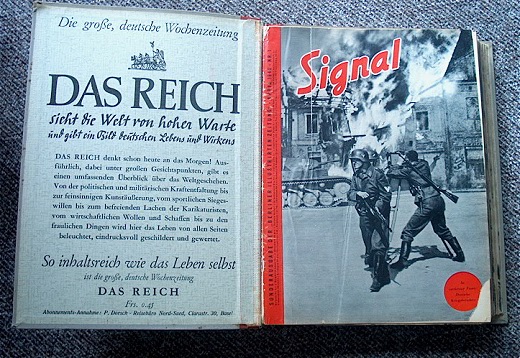
The inner front cover of some of the binders featured an advertisement for Das Reich, a weekly newspaper projected by Goebbels (who would make it his privilege to contribute the leading article twice a month). Published by the Deutscher Verlag, it quickly evolved to become one of the most influential publications of German propaganda, and perhaps only second to Signal in its impact abroad.
Das Reich was mainly circulated inside Germany but was also available to subscribers in Switzerland and other European countries. Just like Signal, Das Reich was fed with exclusive material and wasn't always subjected to the rigid mechanisms of political censorship.
While Signal was designed to appeal to the European youth, Das Reich was set to attract a more intellectual readership. The advertisement made reference to this claim when announcing that Das Reich would "view the world from high lookout".
In a letter written on June 30, 1940, Max Amann, Reich leader of the Press and head of the NSDAP-owned Eher publishing house (the man responsible for the provisioning of printing paper for this new project), further elaborated on this in a letter to the wife of architect Paul Ludwig Troost: "Die Wochenzeitung soll sich im Inland an die politisch und geistig Interessierten richten, die den Entwicklungslinien, inneren Zusammenhängen und tieferen Ursachen dese Geschehens nachspüren und über sie unterrichtet sein wollen. Sie will allwöchentlich einen umfassenden Weltspiegel geben, der unter dem deutschen Blickwinkel steht. Die Überzeugungskraft der Zeitung soll so stark sein, daß das Ausland einschließlich derer, die trotz kritischer Einstellung über Absichten und Entwicklung der deutschen Politik informiert sein wollen und müssen, an ihrem Inhalt nicht vorbeigehen können." |
E. Binder Advertisement
The official Signal binders were advertised through leaflets included with regular copies of Signal. Published in mid- to late-1942, this example promotes the second version of the binders — the first edition had already been sold out at that time.
The authorized distributor for Switzerland also announced they would still have a stock of back issues from 1940 and 1941, and encouraged the reader to start their own Signal collection today.
The price per binder was CHF 8.00, a rather costly invest- ment compared to the single issues of Signal, which in 1942 retailed for CHF 0.45.
So far Switzerland appears to have been the only country in which the binders were ad- vertised and distributed. Nonetheless we must consider the possibility they were also sold in other parts of Europe, especially since the binders were not a Swiss product: they were manufactured by a book- binding service in Leipzig, and it is possible this business exported them to other countries as well. | | 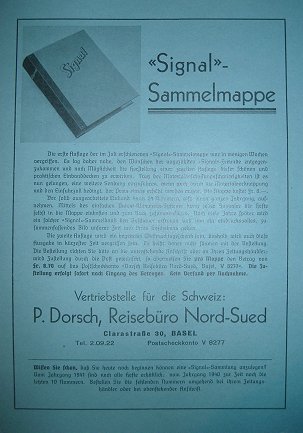 |
If interested in the original German text of the ad, please email me for either a transcript or a larger version of the photo. |
|



 Fig.3
Fig.3 








